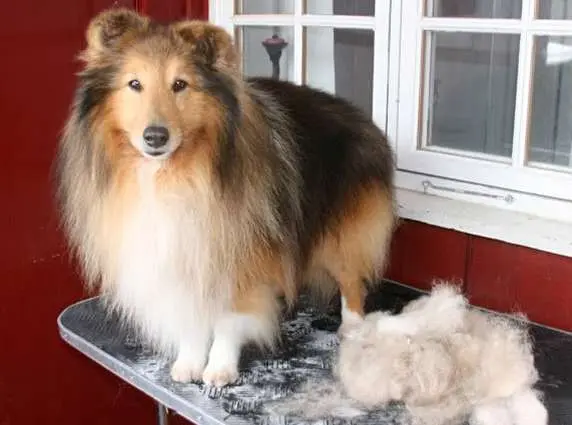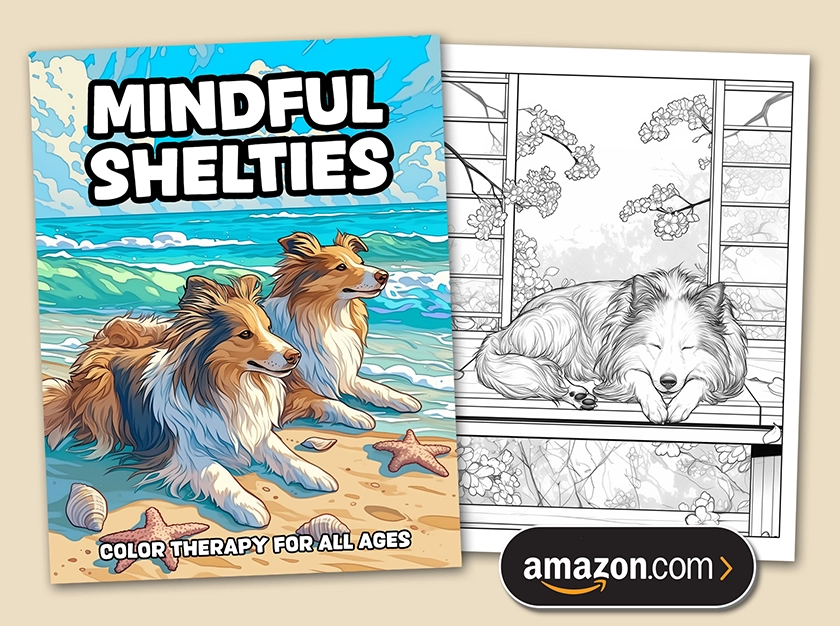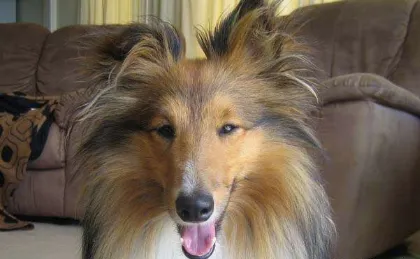Here are the most frequently asked questions about Shelties. Learn about temperament, intelligence, lifespan, health, grooming, puppies, breeders, adoption, training, and more.
- What's the Sheltie temperament like?
- How long do Shetland Sheepdogs live for?
- Are Shelties barkers?
- Are Shelties intelligent?
- Do Shetland Sheepdogs get along with children?
- How much exercise do Shetland Sheepdogs need?
- How do you groom a Shetland Sheepdog?
- How often do you bathe a Sheltie?
- How do you clean a Sheltie's teeth?
- What's the best dog food for a Sheltie?
- Should I spay / neuter my Sheltie?
- What are common genetic issues in Shelties?
- What's the best way to train a Sheltie?
- How do you housebreak a Sheltie puppy?
- How do you socialize a Sheltie puppy?
- How do you teach a Sheltie to swim?
- Do multiple Shetland Sheepdogs get along together?
- Where can I adopt a Sheltie?
- Where can I find Sheltie puppies for sale?
- Should I breed my Shetland Sheepdog?
1. What's the Sheltie temperament like?
The Sheltie temperament is generally intelligent, sensitive, playful, observant, and affectionate. Without proper socialization as puppies, Shelties have a tendency to be shy and anxious, so it's important to introduce them to all kinds of people when young to develop their confidence.
Shelties are well known for their barking. This is not a quiet dog breed. They bark when they're excited or trying to alert you to something in the environment. The good news is barking can be minimized through training.
"Puppies don't bark right away, but when they do find their voice make sure you control it. Allow them to alert you. Then let them know when it's enough. They are the best companion dog—don't expect to ignore a Sheltie and get away with it!" - Dawn Morrow, Sheltie Planet reader
In addition to barking, Shelties also love to sing! In exploring their vocal abilities, some Shelties can find some hilarious yowly voices that sits somewhere between a whine and a howl. When it happens, it's totally adorable.
In terms of temperament, Shelties also make excellent lap dogs. They form close bonds with their owners and don't like to see you leave. They're very affectionate too: they love to nuzzle and receive endless ear scratches and belly rubs. Piper, our sweetie Sheltie, used to sit on my lap for ages while I watched TV in the evenings. Even Howard, our bossy Sheltie, loved to snuggle up when it was time for bed.

The Sheltie temperament is sensitive, quirky, playful, observant, and affectionate.
2. How long do Shetland Sheepdogs live for?
Shelties live for 12-14 years on average. The popular idea that one dog year is equivalent to seven human years is somewhat simplified. The latest research suggest the first year in a dog's like is equivalent to 15 human years. The second year is equivalent to nine years. After that, the rate of ageing is comparatively slower:
Dog Age in Human Years
Dog Years |
Small 0-20 lbs |
Medium 21-50 lbs |
Large 51-100 lbs |
Giant 100+ lbs |
| 1 | 15 | 15 | 15 | 12 |
| 2 | 24 | 24 | 24 | 22 |
| 3 | 28 | 28 | 28 | 31 |
| 4 | 32 | 32 | 32 | 38 |
| 5 | 36 | 36 | 36 | 45 |
| 6 | 40 | 42 | 45 | 49 |
| 7 | 44 | 47 | 50 | 56 |
| 8 | 48 | 51 | 55 | 64 |
| 9 | 52 | 56 | 61 | 71 |
| 10 | 56 | 60 | 66 | 79 |
| 11 | 60 | 65 | 72 | 86 |
| 12 | 64 | 69 | 77 | 93 |
| 13 | 68 | 74 | 82 | 100 |
| 14 | 72 | 78 | 88 | 107 |
| 15 | 76 | 83 | 93 | 114 |
| 16 | 80 | 87 | 99 | 121 |
Extend your Sheltie's lifespan by feeding him nutritious, high quality food; allowing him to run off the leash for at least 30-60 minutes per day; stimulating him mentally through training, dog tricks, and chews; keeping his teeth clean; and taking him for annual vet checks and vaccinations.
Like all dogs, Shetland Sheepdogs are balanced psychologically when they receive both discipline and affection in good measure. Create structure and boundaries when they test the limits, and offer lots of love and affection to reinforce good behaviors.

Shetland Sheepdogs live for 12-14 years on average.
3. Are Shelties barkers?
Shelties can be very vocal dogs. That includes barking, whining, singing, and howling! They only make noise when they have good reason (in their minds), so set the ground rules early when it comes to alarm barking. Train them to give only one or two alarm barks, and rule out endless barking frenzies as an acceptable behavior.
"The Sheltie voice is obnoxious to some, endearing talking to others. The first thing anyone needs to know is that Shelties will certainly tell you what they think. Prospective Sheltie owners should know that they use their bark to herd, notify, and have sentence long conversations!" - Elizabeth Gagliardi, Sheltie Planet reader
If your Sheltie's barking has gotten out of hand, see How to Stop Your Sheltie Barking for three distinct situations and solutions. Bear in mind that barking can be caused by anxiety. If you have an anxious Sheltie, check out the ThunderShirt for Shelties which is proven to induce a calmer, more secure temperament in nervous dogs.

Shelties bark to alert you to perceived threats, as well as to express joy.
4. Are Shelties intelligent?
Shelties are the sixth smartest dog breed in the world. This makes them very easy to train, learning new commands in as little as five repetitions. Frequently eager to please, they also excel in obedience and agility trials.
However, this intelligence also means they require more mental stimulation than most dogs. Shelties need daily mental stimulation through walks, off-leash runs, games, socialization, chew toys, dental chew, and any kind of job you can create around the house.
Fail to stimulate your Sheltie's brain and you'll find you have a bored, frustrated pooch. This manifests in unhealthy behaviors like excessive barking, running in circles, obsessive tracking, destructive chewing, and other anxious habits. If you don't have the time to attend to your dog's mental wellness, a Sheltie is not for you.

Shelties are the sixth smartest dog breed in the world.
5. Do Shetland Sheepdogs get along with children?
Shelties make great family dogs, provided they're socialized with children when young. If you plan to rescue an adult Sheltie, test her reaction to your children first. If she appears physically tense, backs away, barks, or tries to nip at your kids, you may have a difficult rehabilitation ahead. Younger children, in particular, are less accommodating to your Sheltie's emotions. Toddlers make sudden noises, invade personal space, and grab fur, which overwhelms nervous Shelties and leaves them continually unsettled. Such Shelties are better suited to homes with calm, sensitive adults.
The good news is that many well-socialized Shelties can be highly affectionate and welcoming to the attention of people. When you bring a Sheltie puppy home, you have a window of a few months to desensitize her to all kinds of people and situations. She can be fearless at this age, throwing herself into new situations, and as long as she has positive experiences, she will respond in a healthy way to these stimuli for the rest of her life.

Shelties are real softies and get along well with children if they aren't afraid.
6. How much exercise do Shetland Sheepdogs need?
Exercise your Sheltie for at least 30-60 minutes per day. This is the standard minimum for any dog breed. Take them on all outdoor activities where dogs are allowed to prevent boredom and stimulate their active brains. Physical and mental exercise is one of the main joys in life for any dog, so attend to this need as much as you can.
"Train a good recall early on and enjoy wonderful times hiking, running, and mountain biking with your best bud. Hint: always keep a towel or two in the car as mud brushes out easily once dry." - Lisa Morgan, Sheltie Planet reader
If you have a good outdoor space, encourage them to use it in addition to walks. Shelties love to live on farms, but are also suited to apartment living if you make the effort to get them out and about daily. Time to run off the leash is essential.
"I urge anyone and everyone, Sheltie owner or not, to watch The Dog Whisperer with Cesar Millan so you know how to properly socialize your dog and treat it like a dog (not a person). As for Shelties running in circles, this is due mainly to lack of exercise or lack of mental stimulation and can be stopped by increasing exercise or mental stimulation." - Leanne Beck, Sheltie Planet reader
If your Sheltie spins, whines, or is obviously bored, it's a strong indication to go for a walk. Imagine life from their perspective: they aren't stimulated by computers, TV, books, work, conversation, and all the stuff that keeps us occupied. Their first line of stimulation comes from you. Shelties were bred originally to be watchdogs—to watch over and herd sheep—which explains why pet Shelties sit at the window for hours to this day. It's their most natural and instinctive job.
In addition to physical exercise, give your Sheltie mental exercise by training new commands and tricks, exposing her to other dogs and people, and give her jobs to do around the house. Nervous Shelties can also be calmed with a ThunderShirt which is proven to induce a sense of emotional security.

Exercise your Sheltie for at least 30-60 minutes per day.
7. How do you groom a Shetland Sheepdog?
At around five months old, your dog will develop his thick double coat and you'll need to start your Sheltie grooming routine. The adult coat is made up of a soft, woolly undercoat for insulation, and a long, coarser outercoat for protection from the elements. The coat continues to change and develop until Shelties are about three years old.
Shelties shed a reasonable amount of hair, although their diminutive size means it's not nearly as much as large, long-haired breeds like Labradors and German Shepherds. A deep weekly brushing stops most of it from ending up on the living room couch. However, if you procrastinate on grooming, expect a lot more hair and fur to accumulate around the house.
Thoroughly groom your Sheltie for 30-60 minutes every week. A quick daily detangling of the wispy hair behind the ears is an added bonus. Most people enjoy grooming their Shelties once they get down it it as grooming is a tactile, bonding experience. Just be very gentle and calm, and your Sheltie will come to accept it as bonding time too. See How to Groom Your Sheltie for a complete step-by-step guide.
Note that male Shelties blow their coats once a year just before summer, where frequent grooming is needed to keep up with a higher rate of shedding. Female Shelties also shed before summer, as well as after every heat cycle, which hits every 6-8 months in her reproductive years. You can eliminate heat cycles and the related shedding, as well as certain diseases of the reproductive organs, by spaying a female Sheltie in her first year. See The Pros and Cons of Spaying for a detailed overview.

Shelties need weekly grooming for healthy skin and fur.
8. How often do you bathe a Sheltie?
Bathe your Sheltie whenever he needs it; a general guideline is every 1-2 months. Shetland Sheepdogs keep clean by licking and grooming themselves, especially their paws. They're also less prone than other breeds to roll around in animal feces and other nasty scents. So there's no need to go overboard. Ib fact, if you bathe a Sheltie too often, it strips away the natural oils on the skin, causing dryness, flaking, and itching.
When bathing a Sheltie, use lukewarm water to shower him in the tub. Get the nozzle right against his skin, otherwise the waterproof coat protects the undercoat from getting wet. Take care to avoid spraying water in his ear holes; use cotton balls if you're worried. And use a shampoo designed for dogs: TropiClean's PerfectFur Dog Shampoo is ideal for the Sheltie's thick double coats.
After bathing, gently pat him with a towel (rubbing damages wet fur) and allow him to dry off naturally indoors. If your furniture can't take a wet Sheltie rubbing against it, carefully blow dry the coat on a low setting, parting the fur as you go.

Shampoo your Sheltie every 1-2 months.
9. How do you clean a Sheltie's teeth?
Most people ignore cleaning their dog's teeth until it's too late. Some 85% of dogs over three years old already have gum disease, which is a major cause of tooth decay and tooth loss. Eventually your vet will need to perform a deep cleaning of the teeth and gums and even extract the diseased teeth, both of which require a general anesthetic. See my article on How to Clean Your Sheltie's Teeth. In summary, here are three things you can do to avoid painful and expensive outcomes.
Dog Toothbrush and Toothpaste
Remove food debris and plaque with a dog toothbrush and toothpaste every night. Start very gently, allowing your Sheltie to get used to the sensation, and your efficiency will improve over time.
Daily Dental Chews
Mechanically remove tartar with daily dental chews, where antiseptic enzymes combine with the scrubbing action of chewing to clean the teeth and gums. With daily use, they go a long way toward loosening existing tartar while stimulating saliva to protect against new plaque forming.
Water Additives
Besides toothbrushing and dental chews, consider using a water additive that serves as a natural mouthwash and plaque remover. Designed for your dog's water bowl, these liquid additives are safe to drink and stay in the saliva for hours, fighting plaque and tartar. Extra measures like this can reduce the likelihood of painful cavities and tooth extractions down the line.
10. What's the best dog food for a Sheltie?
Quality nourishment in the right amount will help your Sheltie live a long and healthy life. I've written a detailed article called What Is The Best Dog Food? In summary, if you choose dry kibble, know that cheap brands use corn as a filler which fails to provide sufficient protein. What's more, certain additives are known to be toxic. Avoid any dog food that lists in its ingredients:
- Meat and bone meal
- Meat by-products
- Poultry by-product meal
- Propylene glycol
- Ethoxyquin
- BHA & BHT
- Mineral oxides
- Sulfates
Instead, seek out dog foods with a specific meat source at the top of the ingredients list, as well as natural preservatives and additives further down:
- Beef meal
- Lamb meal
- Poultry meal
- Vitamins E & C
- Tocopherols
- Chelated minerals
If you're looking for a shortcut, I recommend premium kibble brands like Hills and Blue Buffalo which meet the above criteria. Note they have different formulas depending on the age and size of your dog, as different dogs have different nutritional needs.
11. Should I spay / neuter my Sheltie?
It's a devastating truth that, in the US alone, an unwanted dog is euthanized every 10 seconds. That's millions of dogs every year. And it's the result of three things: puppy mills, backyard breeding, and unplanned pet pregnancies.
As animal lovers, we can help by desexing our dogs. It's normal to feel weird about desexing your dog. We don't do it to humans, so how can we justify neutering a beloved canine member of the family?
It's important to recognize these are pets, not people. We often treat dogs as our children, but our dogs will never lead independent lives, get married, and raise their own families. A dog's purpose in life is companionship. In return, we take care of their needs and make the best decisions for them.
If you own a male Sheltie, I urge you to read The Pros and Cons of Neutering Your Sheltie. For female Shelties, see The Pros and Cons of Spaying. I have laid out all the major considerations regarding your Sheltie's health.

Spaying and neutering are widely considered the responsible choice.
12. What are common health problems in Shelties?
Purebred dogs come from a limited gene pool with historic inbreeding, which makes them more prone to certain inherited health issues. This is another reason why breeding Shelties should be left to the experts who take careful measures to avoid passing on disease genes.
Shelties originating from backyard breeding or puppy farms are most likely to have genetic health issues such as:
- Patellar Luxation (floating knee cap)
- Hip Dysplasia (malformed hip joint)
- Collie Eye Anomaly (eye deformities)
- Dermatomyositis (inflammatory disease)
- Von Willebrand Disease (blood disorder)
Shelties may also be vulnerable to complications from certain medications. This is linked to the multidrug resistance genetic mutation in dogs, or the MDR1 mutation, which affects how drugs are broken down in the body.
Obesity is also a common health problem in Shelties. It's easy to overfeed such a small dog and not notice the weight gain under all the fur.
"They also are mostly slender, not muscular like Pit Bulls, so obesity can be hiding under that thick coat and can cause premature arthritis. Be aware of the fact that they do not need much food (many are cheap keepers) so get the best quality food you can afford!" - Christel Gezels, Sheltie Planet reader
For a more detailed look, see my article Genetic Diseases in Shelties.

As purebred dogs, Shelties are more prone to certain hereditary diseases than mixed breeds.
13. What's the best way to train a Sheltie?
Shelties are intelligent, sensitive dogs, making them highly responsive to positive reinforcement. This simply means praising all correct behaviors in the moment.
Shelties learn quickly with simple, clear instruction. They can learn new commands in as little as five repetitions. As dogs go, you have an easy job teaching your Sheltie tricks and obedience, and eliminating unwanted behaviors by nipping them in the bud.
In particular, clicker training works great on Shelties as they're so eager and quick to learn. In time, you can do away with the clicks and they respond to commands automatically.
"Shetland Sheepdogs are extremely sensitive to negative feedback and a physical reprimand can be absolutely devastating to their psyche." - Christel Gezels, Sheltie Planet reader

Train your Sheltie with simple demonstrations and positive reinforcement.
14. How do you housebreak a Sheltie puppy?
Housebreaking a puppy can be one of the major challenges of dog ownership, particularly for first-time owners. It means teaching your Sheltie to pee and poop outdoors and not all over your prized living room rug.
You'll need puppy training pads, some delicious dog treats for rewards, and carpet stain remover for the inevitable mistakes.
The most popular method starts with teaching your puppy to eliminate on puppy training pads inside. You'll need to keep a watchful eye and be ready to correct him or praise him every time he goes in the right place. Housebreaking always involves a few spills and messes, but you have to accept that from the outset when you bring home a baby animal.
By the time he's four months old, your puppy's bladder and bowels are large enough and strong enough to transfer the business outdoors. This can be a simple and very rewarding transition for both of you.

Housebreaking your puppy takes place between 2-4 months.
15. How do you socialize a Sheltie puppy?
Like all dog breeds, Sheltie puppies should spend the first 8 weeks of life with their mom and the rest of the litter. This teaches them important socialization skills within their own species like how to share, how to play nice, and what actions are too rough. If they don't learn these skills, they can develop lifelong behavioral problems with other dogs.
The second stage of socialization comes from 8-16 weeks, when puppies settle in with their new families and form strong attachments with humans. Start to socialize your puppy with people from the day you bring him home. This is true for all dog breeds, but Shelties are especially sensitive, and failure to socialize when young can result in severe nervousness and anxiety.
First give him positive play experiences with you and your immediate family. He may be nervous in the first few days so go slowly initially. After the first week, expand his social horizons to include more friends and family in multiple locations. Host gatherings at your home to get him used to lots of people at once. And don't forget to invite noisy kids!
"I was unprepared for how shy they can be with some people they don't know. We socialized her very early by taking her to be around people, but when our next door neighbor reached for her when she was 10 months old, Piper recoiled as if the neighbor was evil!" - Nancy Olsen, Sheltie Planet reader
Take your Sheltie to puppy classes and work on obedience training to build a stronger bond between you. These dedicated sessions can make a big difference.
"As a Sheltie breeder for the last 12 years, I find that the puppies I take to puppy class and agility are the best behaved. The bond and communication between us is much stronger. Yes we can do this at home but I feel it makes a difference taking the puppy to socialize and work with other people and dogs in class. The need to get my attention by barking is lessened." - Michelle Lash-Ruff, Sheltie Planet reader
Once he's had his final vaccinations, he can go to lots of public places: walk around town, sit outside coffee shops, visit the dog park, go on a road trip, and meet all kinds of other animals. Go all out during this phase. Expose him to every scenario he's going to encounter in his lifetime, so he can meet them all in confidence.

Sheltie puppies need high levels of socialization.
16. How do you teach a Sheltie to swim?
Swimming is an excellent way to keep your Shetland Sheepdog fit, especially if she develops arthritis as she ages where running can hurt her joints. Swimming is also a great positive experience to give her as a puppy so she doesn't have the stress of fearing water her whole life. Cue lots of fun beach days or trips to the lake!
Some Shelties love water, while others hate the wet stuff. It all comes down to their natural inclination for adventure and positive exposure when they are young. Follow the steps laid out in e How to Teach Your Sheltie to Swim, which includes safety issues for smaller Shelties and gradual desensitization for water-fearing dogs.

Teach your Sheltie to swim with gradual water desensitization.
17. Do multiple Shetland Sheepdogs get along together?
Many of our readers have multiple Shelties and absolutely love it. Shelties are an addictive breed; once you discover their lovable nature it's hard to stop at one.
"Shelties are like potato chips - you can never have just one!" - Every Sheltie owner ever
If one Sheltie is a joy, then two is double the fun. Having two dogs of the same breed means they play together extremely well. They have the same energy levels, enjoy the same herding based games, and being matched in size they won't accidentally hurt each other when pouncing and scruffing together.
What's more, as highly sensitive dogs, Shelties really don't like being left alone. Having a companion dog to hang around with while you're out of the house is ideal.
The only downside of having multiple Shelties is they can bark each other up. If one dog hears a cat screech in the distance, he'll bark and then other will bark automatically. Getting a handle on barking is essential when you have two or more Shelties!
18. Where can I adopt a Sheltie?
There are many rescue Shelties in need of forever homes. They've already been through a lot in their lives, including abuse or neglect, and almost always abandonment by the families they thought would be with them forever.
Find Shelties rescues near you and give a dog the life he deserves.

There are many Sheltie rescues around the US.
19. Where can I find Sheltie puppies for sale?
Before you buy a Sheltie puppy, please consider a Sheltie rescue first. Your new best friend may already be waiting at your local shelter, desperate for a secure and loving home.
If you have your heart set on a puppy, you can find Sheltie puppies for sale here. Our directory aims to list only ethical Sheltie breeders in the US, UK, Canada, Australia, and New Zealand.
Never buy pet store puppies or deal with puppy farms—both fuel the inhumane puppy mill trade. What's more, puppy mills notoriously sell puppies with in-born diseases and behavioral problems due to lack of early socialization.

Only ever buy Sheltie puppies from legitimate professional breeders.
20. Should I breed my Shetland Sheepdog?
Never breed a pet Sheltie, or any pet dog for that matter. There are enough unwanted dogs in the world without pet owners adding to the mix.
Professional Shetland Sheepdog breeders dedicated a huge amount of time, knowledge, and resources to maintain healthy genetic lines. It means entering potential sires and dams into competitions to identify champions: the best examples of the breed. Ethical breeding also involves genetic testing to screen for inherited diseases in breeding pairs. The goal is to selectively mate the healthiest Shelties with the best temperaments to create the breed we have come to love so dearly.
Pet breeding, backyard breeding, puppy mills, and pet stores take no such care. Not only are their puppies more likely to carry inherited diseases, they're also born solely for the pet trade, at a time when millions of unwanted dogs are euthanized every year. If you turn a blind eye to that and still want to breed your pet dog because it would be cute—just imagine how you'll feel when you have to give those puppies away.
"As a veterinarian I have seen some breeding problems caused by poor breeding choices. To my dismay, 25 years ago my own employer (yes another veterinarian) bred Shelties and every single one of those dogs developed severe allergies, auto-immune diseases, arthritis, and dental problems. My most recent experience with a serious problem was a small, sweet Blue Merle Sheltie who delivered 4 gorgeous, healthy-looking puppies who all died within days due to cleft palates." - Christel Gezels, Sheltie Planet reader
Always leave breeding to the experts and seriously consider getting your male Sheltie neutered or your female Sheltie spayed at the ideal age for the compelling individual and societal benefits.



















